The Wyandotte chicken is one of America’s favorite breeds of chicken – a true heritage chicken breed.
Historically, the Wyandotte chicken was the first American chicken breed that was bred specifically as a dual-purpose chicken.
Wyandotte chickens are friendly, docile birds but are not your typical pet chickens. The average Wyandotte chicken can hardly stand being fussed over.
These beautiful birds come in a variety of colors, including white, silver-laced, golden-laced, red-laced, and blue-laced, and they are remarkably productive.
If you’re thinking about getting chickens, you may want to consider the Wyandotte chicken.
This article details all you need to know about this fascinating breed of chicken.
Keep reading to learn more!
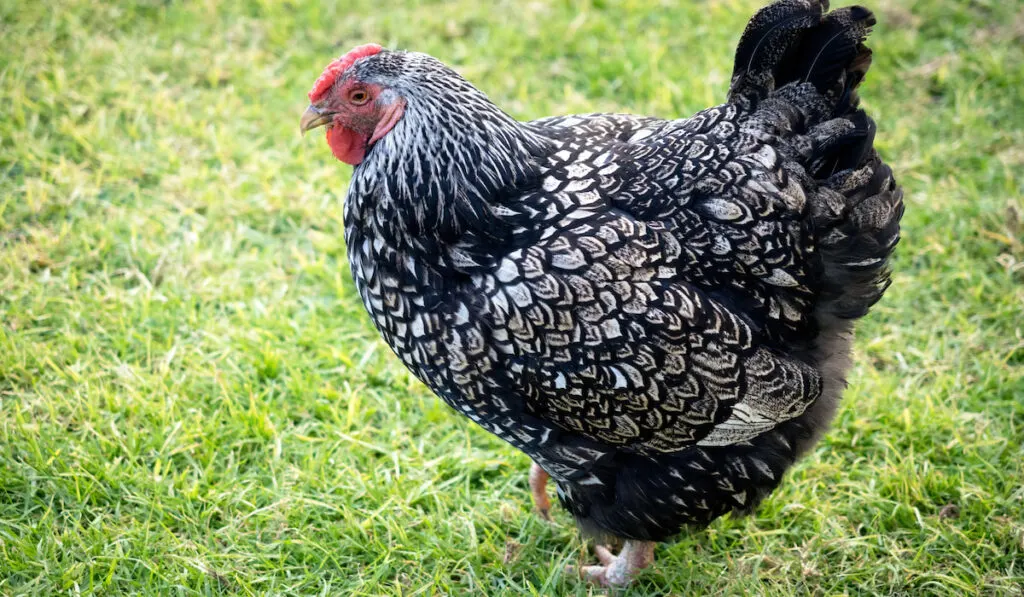
Table of Contents
Wyandotte Chicken Breed History
The Wyandotte chicken is an American breed developed in the late 1800s. It was named after a Native American tribe, the Wyandot Indian tribe, who lived in the Great Lakes region of North America.
Before the name Wyandotte was adopted, the Wyandotte chicken was popularly known to the locals as American Sebrights.
The American Poultry Association Standard of Perfection changed the name to Wyandotte after the breed was admitted in 1883.
The first recognized variant of the Wyandotte chicken breed was the Silver-Laced variant.
Although its origin is uncertain and debatable, it’s mostly believed to have been developed from crosses between the Spangled Hamburg chicken, Dark Brahma chicken, and a few other breeds.
Wyandotte Chicken Key information
| Breed name | Wyandotte |
| Breed classification | Large |
| Colors | Varied |
| Weight | 6.5 – 8.5 lbs. |
| Temperament | Friendly, docile |
| Purpose | Meat and eggs |
| Productivity | 220–280 eggs per year |
| Tolerance | Cold-hardy and heat tolerant |
| Egg size | Medium to large |
| Egg color | Light to medium brown |
| Broodiness level | High |
| Feathered legs | No |
| Care requirement | Low |
Wyandotte Chicken Appearance and Features
Wyandotte chickens are one of the most beautiful breeds of chicken.
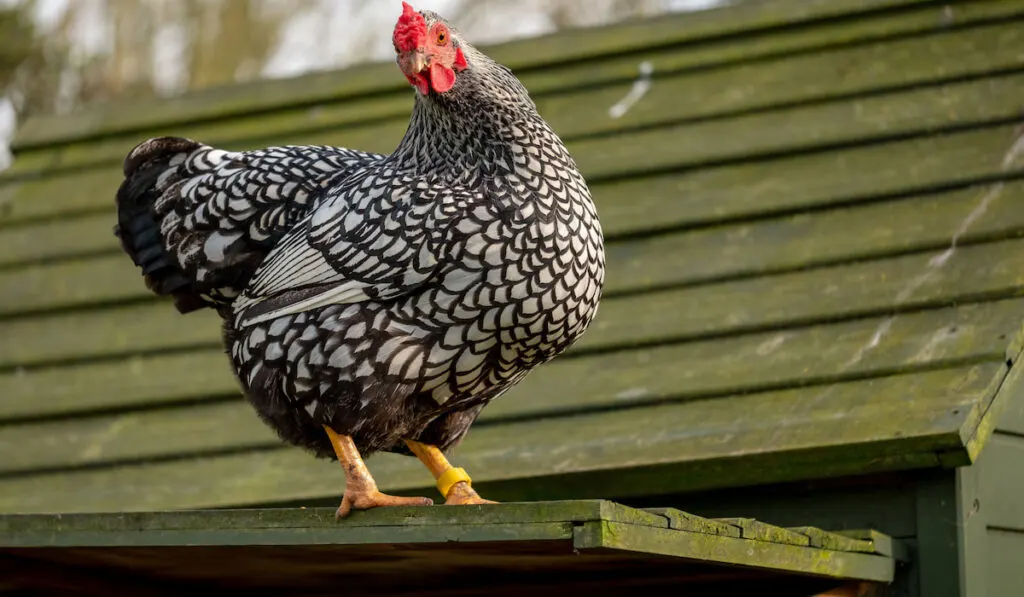
They have rounded bodies and well-proportioned wings. They are also clean-legged, i.e., they don’t have feathered legs and have rose combs.
The Wyandotte chicken’s plumage is dense and tight, with a distinctive lacing pattern that is most pronounced on the hen’s back.
The color of the lacing varies depending on the variety and can range from silver to blue or black or brown.
These unique feathering patterns and lacing make them stand out, and some people prefer to keep them as pets or show birds just because of their beautiful plumage.
Standard Wyandotte chickens have a rose or pea comb with pronounced rounded points.
You may come across Wyandotte chickens with a single-type comb, but they are not considered standard.
The rose comb was considered more practical as it is not as susceptible to frostbite like the single comb. Therefore, the rose comb became the recognized standard for the breed.
This comb size varies between the sexes, and roosters have more prominent combs than hens.
Wyandotte chickens have distinct featherings on their hackle feathers. Roosters have full-flowing hackles, unlike hens, and their tails are held at a 40° angle.
Wyandotte chickens are yellow-skinned, four-footed birds. They have bright red, medium-sized wattles and earlobes. Uniquely, their faces are also bright red.

Wyandotte Chicken Varieties
There are several varieties of Wyandotte chickens, each with unique coloration and markings.
However, not all varieties of these chickens are considered standard for the breed.
The number of recognized varieties mostly depends on which country or part of the world you live in. Each country has varying numbers of recognized varieties.
Often, varieties recognized as a standard in one country may not be recognized as such in other countries.
For instance, there are 30 recognized Wyandotte varieties in Europe, while the American Poultry Association recognizes only nine (9) varieties.
The APA’s first recognized Wyandotte chicken variety (and the most common) is the Silver Laced Wyandotte, which has silver-laced feathers and white skin.
Other popular varieties, as recognized by the APA, include:
- The Black Wyandotte,
- The Blue Wyandotte,
- The Buff Wyandotte,
- The Columbian Wyandotte,
- The Golden Laced Wyandotte,
- The Partridge Wyandotte,
- The Silver Penciled Wyandotte, and
- The White Wyandotte.
The APA currently does not acknowledge some varieties of Wyandotte chicken. These are:
- The Barred Wyandotte,
- The Birchen Wyandotte,
- The Partridge Wyandotte,
- The Silver Penciled Wyandotte,
- The Black-Breasted Red Wyandotte,
- The Brown Red Wyandotte,
- The Buff Columbian Wyandotte,
- The Blue-Laced Red Wyandotte,
- The Lemon Blue Wyandotte,
- The Blue Columbian Wyandotte,
- The Blue Barred Wyandotte,
- The Splash Wyandotte,
- The White-Laced Red Wyandotte
- The Black-Laced Red Wyandotte,
- The Lavender Wyandotte,
- The Chocolate Wyandotte, and
- The Violet-Laced Wyandotte.
Each of these varieties has unique features peculiar to the variety, and because there are different varieties, people can choose which variety best suits them.
The Wyandotte chicken breed also has bantam varieties. The APA recognizes ten (10) bantam varieties, as opposed to the American Bantam Association (ABA), which recognizes 18 bantam varieties of the Wyandotte chicken.
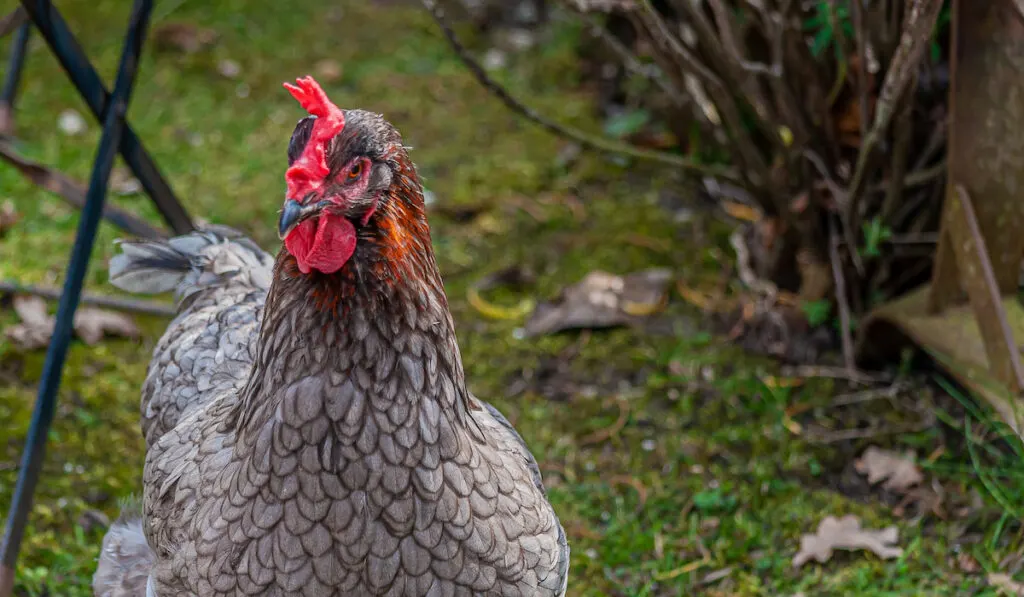
Wyandotte Chicken Size and Weight
Wyandotte chickens are considered a heavy breed. They have a well-rounded medium-length body, broad back, and a deep full chest.
The weight of standard and bantam versions of the Wyandotte chicken are as follows:
Standard
- Roosters: 8-9 lbs.
- Hens: 6-7 lbs.
- Cockerels: 7.5 lbs.
- Pullets: 5.5 lbs.
Bantam
- Roosters: 26-30 oz.
- Hens: 24-26 oz.
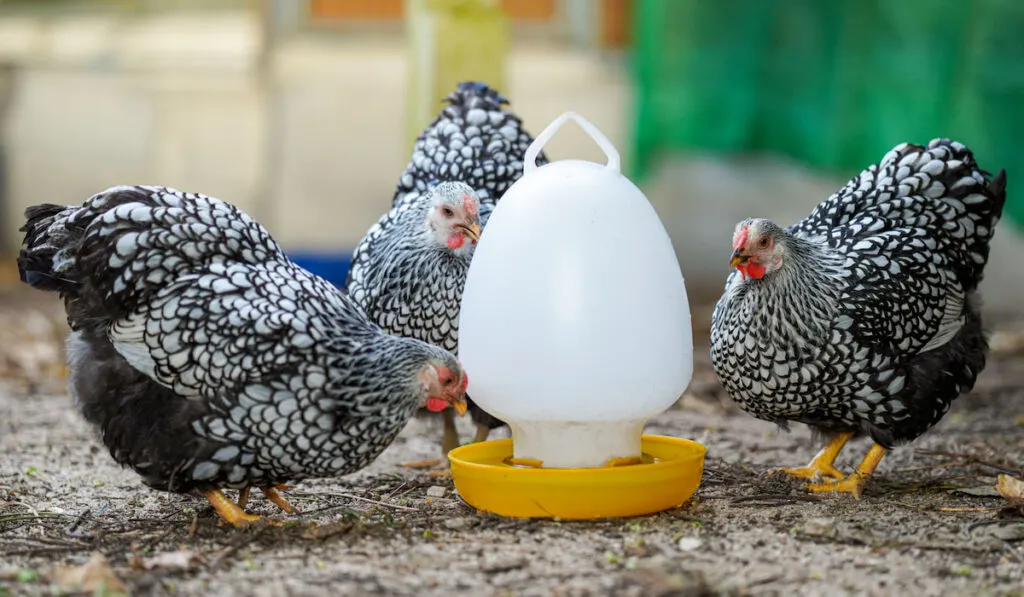
Wyandotte Chicken Personality and Temperament
The Wyandotte chicken is a friendly and docile breed well-suited for backyard flocks.
These chickens are good layers of brown eggs and are known for being excellent mothers.
Wyandotte chickens are also one of the most cold-hardy breeds, making them a good choice for those who live in colder climates. They are also happy foragers and do well in free-range systems.
However, Wyandotte chickens can be loud. They seem to have much to say, and you’re bound to catch them clucking and murmuring about something time and time again.
Wyandotte roosters are known to stand tall and crow loudly, especially in the early hours of the day. Hens aren’t as loud as the roosters but are definitely not quiet.
They can get aggressive if they’re being bullied in the flock, but they are not usually aggressive. They can also hold their own against predators.
They are generally calm and friendly. However, they aren’t big on cuddles or petting. Wyandottes are content just being on their own in the coop.
Overall, the Wyandotte breed is an active and alert bird that is relatively easy to handle. But if you have zero tolerance for noise, Wyandotte chickens may not be for you.
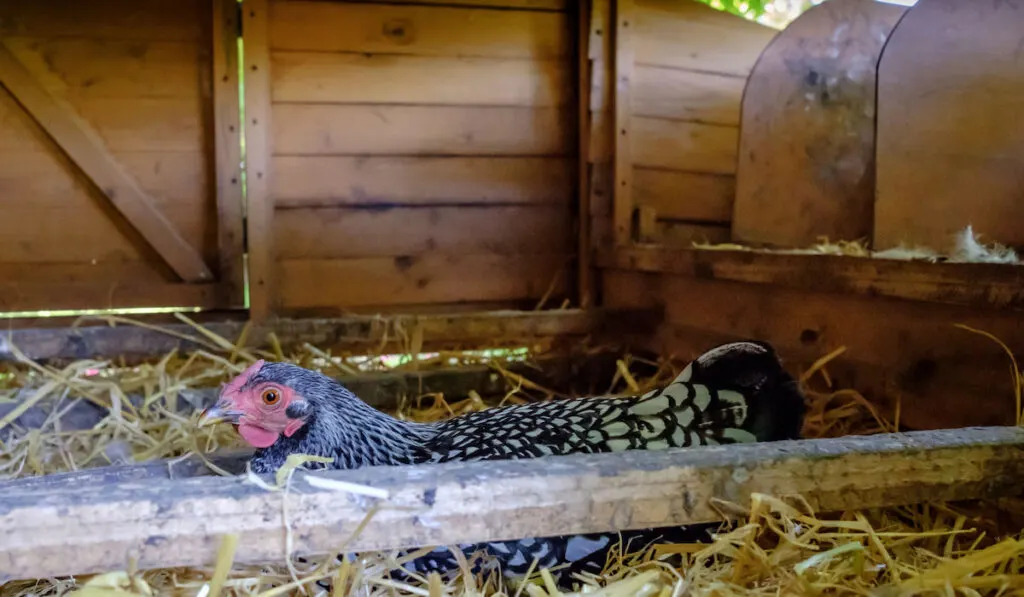
Wyandotte Chicken: Egg Production
Wyandotte chickens are known for being good egg layers and are considered one of the best egg-laying breeds.
Wyandotte chickens lay about 4-5 large brown eggs per week, totaling 220-280 eggs annually.
While some varieties are more productive than others, the average Wyandotte produces no less than 180 eggs per year.
So, if you’re looking for a reliable egg source, you can’t go wrong with the Wyandotte chicken.
They are also known for being good mothers and often go broody, which means they will sit on a nest of eggs to hatch them.
Wyandotte Chicken: Meat Production
The Wyandotte chicken breed is well suited for meat production.
Wyandotte chickens were bred for meat and egg production, and they deliver well on both sides.
The Wyandotte chickens have large bodies with plenty of breast meat.
Wyandotte chickens typically reach butcher weight at about six months of age.
A full-grown Wyandotte chicken, when dressed, has a table weight of 5-7 lbs.
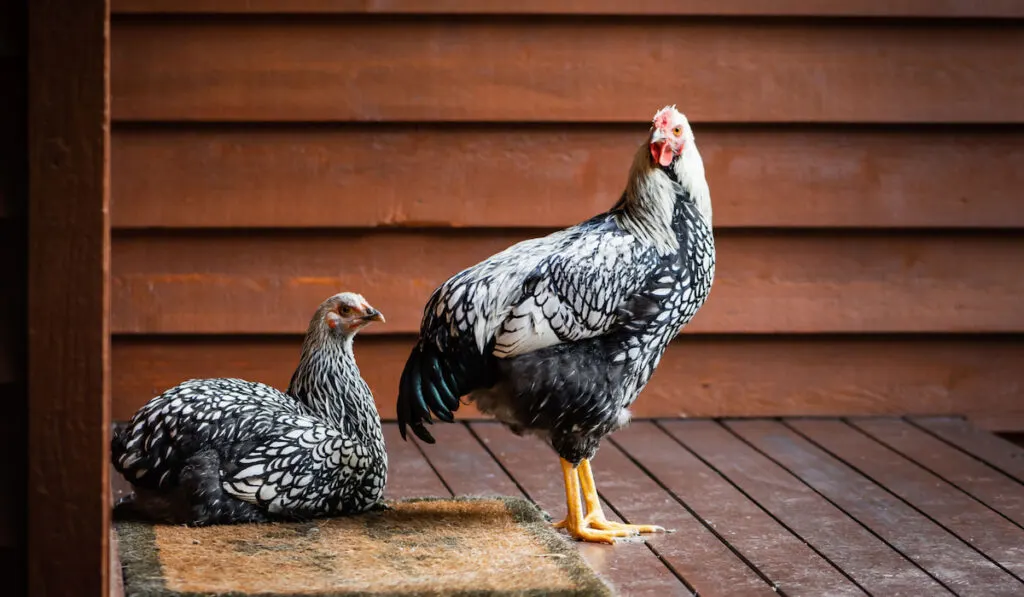
Caring for Your Wyandotte Chicken
As with any chicken breed, there are certain things you need to do to keep your Wyandotte healthy and happy.
Here are some key points to remember when caring for your Wyandotte chickens:
- Provide plenty of clean, fresh water at all times.
- Wyandotte chickens require a good quality diet rich in protein and nutrients. A commercial chicken feed will usually suffice, but you can supplement it with scratch grains, greens, and other healthy foods.
- Keep the coop clean and dry, with plenty of ventilation. This will help prevent respiratory problems.
- Wyandotte chickens are relatively cold hardy but still need shelter from extreme weather conditions. Make sure the coop is well-insulated and draft-free.
- Provide plenty of space for your Wyandotte chickens to move around and exercise. A run or large enclosure is ideal.
Following these simple tips ensures that your Wyandotte chickens have a long and healthy life.
Conclusion
The Wyandotte chicken is an excellent breed for beginner and experienced farmers alike.
They are dual-purpose birds, meaning they can be used for meat and eggs.
Although not very cuddly, they are ideal for backyard flocks or small homesteads with their friendly personalities and easy-going nature.
They also deliver as show birds. Their striking plumage, which comes in different patterns and colors, makes them showstoppers.
They have a good feed-conversion rate, consistently lay eggs throughout the year, and can handle colder climates better than other breeds.
Regardless of how you choose to use them, Wyandotte chickens make great additions to any flock.
So, if you’re looking for an all-around quality bird, then definitely consider adding Wyandotte chickens to your flock!
Resources
- https://backyardpoultry.iamcountryside.com/chickens-101/wyandotte-chicken-june-breed-of-the-month/
- https://breeds.okstate.edu/poultry/chickens/wyandotte-chickens.html
- https://agronomag.com/wyandotte-chickens/
- https://www.thefeatherbrain.com/blog/wyandotte-chickens
- https://www.thehappychickencoop.com/wyandotte-chicken/
- https://www.backyardchickencoops.com.au/blogs/learning-centre/wyandottes-a-comprehensive-guide
- https://www.raising-happy-chickens.com/wyandotte-chickens.html
- https://livestockconservancy.org/about-us/conservation-successes/wyandotte-chicken/
- https://www.chickensandmore.com/wyandotte-chicken/
- https://www.mcmurrayhatchery.com/silver_laced_wyandottes.html
- https://www.thehappychickencoop.com/chicken-breeds/
